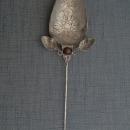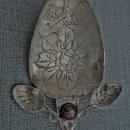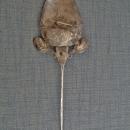Antique Spanish Colonial South American Silver Shawl Pin Ttipqui Tupo Tupu



$380.00
Or Best OfferAntique 17th -18th century Spanish Colonial South American silver cloak pin Ttipqui (Tupo or Tupu) in the form of a spoon from the Andean regions of South America.
The pin was made by the native people and used to fasten the manta or traditional women's shawl, signifying the wearer's wealth.
The beautiful hand-hammered coin silver spoon-shaped pin has edges decorated with marks made to resemble rope turnings.
The spoon bowl has edges decorated with marks that resemble rope-turning features and is engraved with a large flower head with a perching bird on the top and adorned at the bottom with round faceted paste gem (leaded glass), flanked by two small spoons. On the back side of the spoon, there is a small hook for attaching the spoon part to the shawl or clothing.
SOURCE: A comparable example of the Ttipqui, dated to the 17th century, is in the collection of the most important world museum, the Blanton Museum of Art. Please see the links below:
https://hyperallergic.com/766296/the-complex-fashi...
MEASUREMENTS:
Overall length: 26 cm (10.24 inches)
Width at the widest point: 9 cm (3.54 inches)
WEIGHT: 42 Grams
CONDITION: Showing age and usage, minor crack on the right edge of the bowl.
NOTE: After the Spanish invasion in the 1530s, Andean women continued to use pins to secure their garments, though clothing and pin styles changed, as did metalworking techniques. In many regions, acsus were gradually replaced by European-style blouses and skirts. Llicllas, however, survived and are still worn by many Andean women today. While the function of garment pins has thus been consistent across the pre- and post-invasion periods, pins from the latter era are most often used as ttipquis. Garment pins also appear in various new shapes, including spoons (1982.420.13), shells, flowers, suns, and large birds such as peacocks, turkeys, and eagles (1982.420.10). Some nineteenth-century pins, known as picchis, are associated with Aymara communities in the Lake Titicaca region; they have very short shafts, heads often executed in the round, and pendants in the shape of fish with articulated bodies (see, for example, the collection of pins at the Museo de Arte de Lima, Peru).
Post-invasion pins are predominantly made of silver, using techniques like repoussé and engraving, which were rarely employed for ancient Andean pins (though repoussé was regularly used for other objects, such as the Chimú silver disks in the Metropolitan's collection, 66.196.44 and 1978.412.144). In addition, they often feature European-style decorations and imagery, such as floral and vegetal designs, interlace, scrolls, mermaids, human figures, and faceted stones and paste gems. The latter, made from molded or cut leaded glass, were especially popular in Europe and the Americas in the eighteenth and nineteenth centuries. Although less costly than precious gemstones, the finest paste gems were very high quality and highly valued.
While the shape of the Metropolitan's ttipqui is reminiscent of a tulip, it may, for an Andean viewer or wearer, have also evoked native ñucchu flowers (members of the Salvia genus). These flowers are depicted in profile, with the pistil emerging from two open petals, on some ritual drinking cups known as keros as well as on viceregal textiles; see, for example, the flowers on a miniature tunic (2007.470) and a tapestry fragment (2011.324) in the Metropolitan's collection. Red ñucchu flowers, including Salvia tubiflora Smith and Salvia dombeyi Epl, were sacred to the Inca, and both Salvia dombeyi Epl and another red ñucchu, Salvia oppositiflora Ruiz and Pávon, have been used in Holy Week and Corpus Christi processions in Peru and Bolivia since the viceregal period. Thus, this ttipqui may have been especially appealing to an Andean woman who sought to embrace the rich and complex visual traditions, spanning the Precolumbian, viceregal, and Republican periods, that were unique to her homeland.
Kate E. Holohan, 2016
Andrew W. Mellon Fellow, Department of the Arts of Africa, Oceania, and the Americas
Further Reading
Esteras Martín, Cristina. Platería del Perú virreinal, 1535-1825. Madrid: Grupo BBV and Lima: Banco Continental, 1997.
Phipps, Elena, Joanna Hecht, and Cristina Esteras Martín. The Colonial Andes: Tapestries and Silverwork, 1530-–1830. New York: The Metropolitan Museum of Art, 2004.
Vetter Parodi, Luisa María and Paloma Carcedo de Mufarech. El tupo: Símbolo ancestral de identidad femenina. Lima: Gráfica Biblos S.A., 2009.


